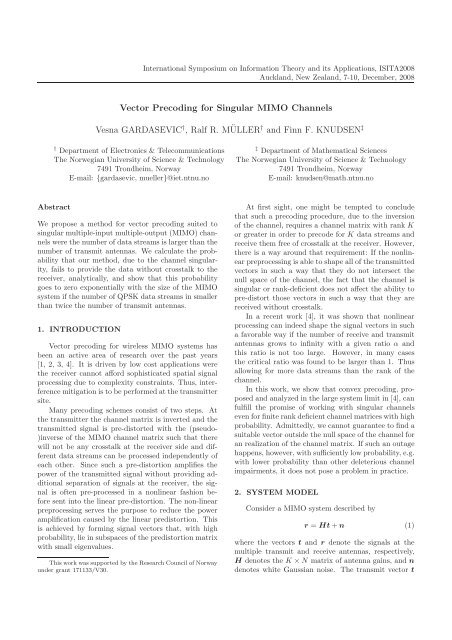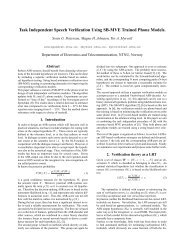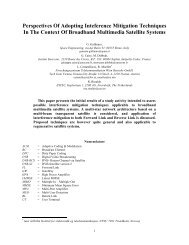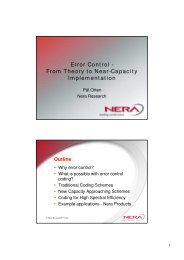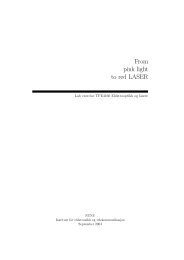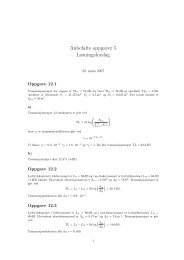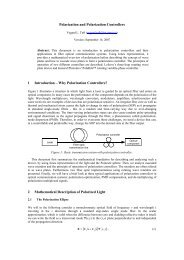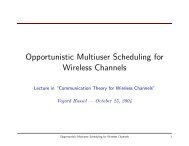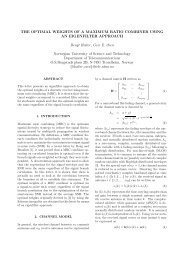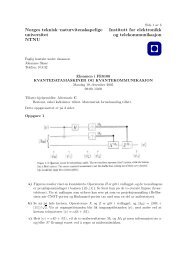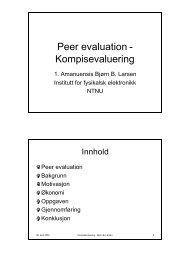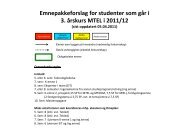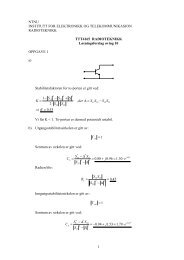International Symposium on Information Theory and its ... - NTNU
International Symposium on Information Theory and its ... - NTNU
International Symposium on Information Theory and its ... - NTNU
Create successful ePaper yourself
Turn your PDF publications into a flip-book with our unique Google optimized e-Paper software.
<str<strong>on</strong>g>Internati<strong>on</strong>al</str<strong>on</strong>g> <str<strong>on</strong>g>Symposium</str<strong>on</strong>g> <strong>on</strong> Informati<strong>on</strong> <strong>Theory</strong> <strong>and</strong> <strong>its</strong> Applicati<strong>on</strong>s, ISITA2008<br />
Auckl<strong>and</strong>, New Zeal<strong>and</strong>, 7-10, December, 2008<br />
Vector Precoding for Singular MIMO Channels<br />
Vesna GARDASEVIC † , Ralf R. MÜLLER† <strong>and</strong> Finn F. KNUDSEN ‡<br />
† Department of Electr<strong>on</strong>ics & Telecommunicati<strong>on</strong>s<br />
The Norwegian University of Science & Technology<br />
7491 Tr<strong>on</strong>dheim, Norway<br />
E-mail: {gardasevic, mueller}@iet.ntnu.no<br />
‡ Department of Mathematical Sciences<br />
The Norwegian University of Science & Technology<br />
7491 Tr<strong>on</strong>dheim, Norway<br />
E-mail: knudsen@math.ntnu.no<br />
Abstract<br />
We propose a method for vector precoding suited to<br />
singular multiple-input multiple-output (MIMO) channels<br />
were the number of data streams is larger than the<br />
number of transmit antennas. We calculate the probability<br />
that our method, due to the channel singularity,<br />
fails to provide the data without crosstalk to the<br />
receiver, analytically, <strong>and</strong> show that this probability<br />
goes to zero exp<strong>on</strong>entially with the size of the MIMO<br />
system if the number of QPSK data streams in smaller<br />
than twice the number of transmit antennas.<br />
1. INTRODUCTION<br />
Vector precoding for wireless MIMO systems has<br />
been an active area of research over the past years<br />
[1, 2, 3, 4]. It is driven by low cost applicati<strong>on</strong>s were<br />
the receiver cannot afford sophisticated spatial signal<br />
processing due to complexity c<strong>on</strong>straints. Thus, interference<br />
mitigati<strong>on</strong> is to be performed at the transmitter<br />
site.<br />
Many precoding schemes c<strong>on</strong>sist of two steps. At<br />
the transmitter the channel matrix is inverted <strong>and</strong> the<br />
transmitted signal is pre-distorted with the (pseudo-<br />
)inverse of the MIMO channel matrix such that there<br />
will not be any crosstalk at the receiver side <strong>and</strong> different<br />
data streams can be processed independently of<br />
each other. Since such a pre-distorti<strong>on</strong> amplifies the<br />
power of the transmitted signal without providing additi<strong>on</strong>al<br />
separati<strong>on</strong> of signals at the receiver, the signal<br />
is often pre-processed in a n<strong>on</strong>linear fashi<strong>on</strong> before<br />
sent into the linear pre-distorti<strong>on</strong>. The n<strong>on</strong>-linear<br />
preprocessing serves the purpose to reduce the power<br />
amplificati<strong>on</strong> caused by the linear predistorti<strong>on</strong>. This<br />
is achieved by forming signal vectors that, with high<br />
probability, lie in subspaces of the predistorti<strong>on</strong> matrix<br />
with small eigenvalues.<br />
This work was supported by the Research Council of Norway<br />
under grant 171133/V30.<br />
At first sight, <strong>on</strong>e might be tempted to c<strong>on</strong>clude<br />
that such a precoding procedure, due to the inversi<strong>on</strong><br />
of the channel, requires a channel matrix with rank K<br />
or greater in order to precode for K data streams <strong>and</strong><br />
receive them free of crosstalk at the receiver. However,<br />
there is a way around that requirement: If the n<strong>on</strong>linear<br />
preprocessing is able to shape all of the transmitted<br />
vectors in such a way that they do not intersect the<br />
null space of the channel, the fact that the channel is<br />
singular or rank-deficient does not affect the ability to<br />
pre-distort those vectors in such a way that they are<br />
received without crosstalk.<br />
In a recent work [4], it was shown that n<strong>on</strong>linear<br />
processing can indeed shape the signal vectors in such<br />
a favorable way if the number of receive <strong>and</strong> transmit<br />
antennas grows to infinity with a given ratio α <strong>and</strong><br />
this ratio is not too large. However, in many cases<br />
the critical ratio was found to be larger than 1. Thus<br />
allowing for more data streams than the rank of the<br />
channel.<br />
In this work, we show that c<strong>on</strong>vex precoding, proposed<br />
<strong>and</strong> analyzed in the large system limit in [4], can<br />
fulfill the promise of working with singular channels<br />
even for finite rank deficient channel matrices with high<br />
probability. Admittedly, we cannot guarantee to find a<br />
suitable vector outside the null space of the channel for<br />
an realizati<strong>on</strong> of the channel matrix. If such an outage<br />
happens, however, with sufficiently low probability, e.g.<br />
with lower probability than other deleterious channel<br />
impairments, it does not pose a problem in practice.<br />
2. SYSTEM MODEL<br />
C<strong>on</strong>sider a MIMO system described by<br />
r = Ht+ n (1)<br />
where the vectors t <strong>and</strong> r denote the signals at the<br />
multiple transmit <strong>and</strong> receive antennas, respectively,<br />
H denotes the K × N matrix of antenna gains, <strong>and</strong> n<br />
denotes white Gaussian noise. The transmit vector t
is formed by a linear transformati<strong>on</strong> with the pseudoinverse<br />
of the channel<br />
( ) −1<br />
t = H + x = lim H † HH † + ɛI x (2)<br />
ɛ→0<br />
out of the precoded vector x. The precoded vector x<br />
is chosen to uniquely represent the data vector s.<br />
3. CONVEX PRECODING<br />
In this work, the data vector will be quaternary s ∈<br />
{±1±j} K <strong>and</strong> the precoded vector x =[x 1 ,x 2 ,...,x K ]<br />
fulfills<br />
R(x k )R(s k ) ≥ 1 ≤I(x k )I(s k ) ∀k. (3)<br />
This allows to find the precoded vector by c<strong>on</strong>vex<br />
quadratic programming. Let X (s) denote the set of<br />
all vectors x such that (3) holds. Then, the precoded<br />
vector that minimizes the transmitted power for a given<br />
data vector s is given by<br />
( ) −1<br />
x = argmin lim<br />
ξ∈X (s) ɛ→0 ξ† HH † + ɛI ξ. (4)<br />
If the limit ɛ → 0 in (4) exists, the precoded vector x<br />
lies in the space spanned by the channel, i.e.<br />
(<br />
x ∈ Span HH †) , (5)<br />
<strong>and</strong> the received signal is free of interference <strong>and</strong> solely<br />
disturbed by additive noise<br />
r = x + n. (6)<br />
The limit in (4) clearly always exists, if the matrix<br />
HH † has full rank. If H is a r<strong>and</strong>om matrix with independent<br />
Gaussian entries, it has full rank with probability<br />
1, if <strong>and</strong> <strong>on</strong>ly if K ≤ N.<br />
4. SINGULAR CHANNELS<br />
Let us now focus <strong>on</strong> the questi<strong>on</strong> whether the limit<br />
ɛ → 0 exists for singular channel matrices, i.e.<br />
(<br />
rank HH †) < K. (7)<br />
Hereby, we restrict the c<strong>on</strong>siderati<strong>on</strong>s to channel matrices<br />
H with entries that are independent complex<br />
Gaussian r<strong>and</strong>om variables with zero mean <strong>and</strong> variance<br />
1/N .<br />
This questi<strong>on</strong> was answered in the large matrix limit<br />
K = αN → ∞ with fixed ratio α in [4] where the<br />
transmitted energy per symbol E was shown to be the<br />
soluti<strong>on</strong> to<br />
Q<br />
(√ )<br />
2<br />
αE<br />
= 2 + (α − 1)E + √<br />
αE<br />
π e− 1<br />
αE<br />
2+αE<br />
(8)<br />
where Q(x) = ∫ ∞<br />
x<br />
exp(−ξ2 /2)dξ/ √ 2π. Since the energy<br />
per symbol diverges to infinity at the threshold<br />
ratio α, the Q-functi<strong>on</strong> can be developed into a series<br />
for small argument, <strong>and</strong> it can be shown that the energy<br />
stays finite as l<strong>on</strong>g as α< 2. Thus, in the limit of<br />
a very large number of antennas, the channel need not<br />
have full rank, but <strong>on</strong>ly half rank.<br />
We now answer the questi<strong>on</strong> for matrices of finite<br />
size. The questi<strong>on</strong> is equivalent to calculating the probability<br />
that there is no interference<br />
P (s) = Pr(r = x + n|s) (9)<br />
(<br />
)<br />
= Pr X (s) ∩ Span(HH † ) ≠ ∅ (10)<br />
Note that by the unitary invariance of HH † , the probability<br />
does not depend <strong>on</strong> the data vector s <strong>and</strong> we<br />
choose without loss of generality s k = 1 + j, ∀k, i.e.<br />
s = 1 +j1. Moreover, the span is invariant to the<br />
norm of <strong>its</strong> bases. Thus, it is irrelevant whether<br />
or just<br />
R(x k ) ≥ 1 ≤I(x k ), ∀k (11)<br />
R(x k ) > 0 < I(x k ), ∀k. (12)<br />
In this respect the following result from [5] turns<br />
out helpful:<br />
Theorem 1 Let R be an N×K matrix composed of independent<br />
identically distributed real Gaussian r<strong>and</strong>om<br />
variables, then the probability that span(R) c<strong>on</strong>tains a<br />
vector whose comp<strong>on</strong>ents are all positive is given by<br />
N−1<br />
∑<br />
2 1−K<br />
l=0<br />
( K − 1<br />
l<br />
)<br />
. (13)<br />
The result can be extended to the complex case [6]:<br />
Corollary 1 Let C be an N × K matrix composed of<br />
independent identically distributed complex Gaussian<br />
r<strong>and</strong>om variables, then the probability that span(C)<br />
c<strong>on</strong>tains a vector for which both real parts <strong>and</strong> imaginary<br />
parts of all comp<strong>on</strong>ents are positive is given by<br />
2N−1<br />
∑<br />
P (K, N) =2 1−2K<br />
l=0<br />
(<br />
2K − 1<br />
l<br />
)<br />
. (14)
5. CONCLUSIONS<br />
1!P(K,N)<br />
10 !1<br />
10 !2<br />
10 !3<br />
10 !4<br />
10 !5<br />
N=4<br />
N=8<br />
10 !6<br />
N=16<br />
N=32<br />
10 !7<br />
N=64<br />
N=128<br />
10 !8<br />
1 1.2 1.4 1.6<br />
α<br />
1.8 2 2.2<br />
10 0<br />
We have presented a method for vector precoding<br />
<strong>on</strong> singular MIMO channels <strong>and</strong> shown that the<br />
method can be used to increase the number of transmitted<br />
data streams significantly bey<strong>on</strong>d the number<br />
of transmit antennas. The extend to which that is possible<br />
depends <strong>on</strong> the number of antennas in the system<br />
<strong>and</strong> the tolerable outage probability.<br />
Acknowledgments<br />
The authors would like to thank Prof. Alexei Rudakov<br />
for helpful discussi<strong>on</strong>s <strong>and</strong> Rodrigo de Miguel for proofreading<br />
of the manuscript.<br />
References<br />
Figure 1: Probability that c<strong>on</strong>vex precoding fails to<br />
find a soluti<strong>on</strong> vs. the ratio of number of receive to<br />
number of transmit antennas.<br />
Note that for matrices with half rank, i.e. K =2N,<br />
we find<br />
P (2N, N) = 1 (15)<br />
2<br />
<strong>and</strong><br />
P (K, K − N) = 1 − P (K, N). (16)<br />
The probability that c<strong>on</strong>vex precoding fails to find<br />
a soluti<strong>on</strong> is plotted in Fig. 1. It can be observed that<br />
a significant overload is tolerable while keeping the failure<br />
probability small. This holds particularly for large<br />
number of antennas. In systems with subsequent error<br />
c<strong>on</strong>trol coding, where failure probabilities of even a few<br />
percent are tolerable, a MIMO system could be at 50%<br />
to 80% overloaded with c<strong>on</strong>vex precoding.<br />
It is worth to be remarked that a failure does not<br />
mean that all data b<strong>its</strong> are lost. It just means that it<br />
is impossible to send all data b<strong>its</strong> of a symbol vector s<br />
free of interference. It is still possible <strong>and</strong> actually quite<br />
likely that some of the data b<strong>its</strong> can be successfully be<br />
precoded for. To find the probability of failure <strong>on</strong> the<br />
basis of the comp<strong>on</strong>ents of the data vector s is a harder<br />
problem which is left for future research.<br />
[1] Robert F.H. Fischer. Precoding <strong>and</strong> Signal Shaping<br />
for Digital Transmissi<strong>on</strong>. John Wiley & S<strong>on</strong>s, 2002.<br />
[2] Bertr<strong>and</strong> M. Hochwald, C.B. Peel, <strong>and</strong> A.L.<br />
Swindlehurst. A vector-perturbati<strong>on</strong> technique<br />
for near-capacity multiantenna multiuser<br />
communicati<strong>on</strong>-Part II: Perturbati<strong>on</strong>. IEEE<br />
Transacti<strong>on</strong>s <strong>on</strong> Communicati<strong>on</strong>s, 53(3):537–544,<br />
March 2005.<br />
[3] M. Joham, W. Utschick, <strong>and</strong> J.A. Nossek. Linear<br />
transmit processing in MIMO communicati<strong>on</strong><br />
systems. IEEE Transacti<strong>on</strong>s <strong>on</strong> Signal Processing,<br />
53(8):2700–2712, August 2005.<br />
[4] Ralf R. Müller, D<strong>on</strong>gning Guo, <strong>and</strong> Aris L. Moustakas.<br />
Vector precoding for wireless MIMO systems:<br />
A replica analysis. IEEE Journal <strong>on</strong> Selected Areas<br />
in Communicati<strong>on</strong>s, 26(3):530–540, April 2008.<br />
[5] J. G. Wendel. A problem in geometric probability.<br />
Mathematica Sc<strong>and</strong>inavica, 11:109–111, 1962.<br />
[6] Finn F. Knudsen. A problem in geometric probability.<br />
Submitted to Applied Probability Trust, August<br />
2008.


